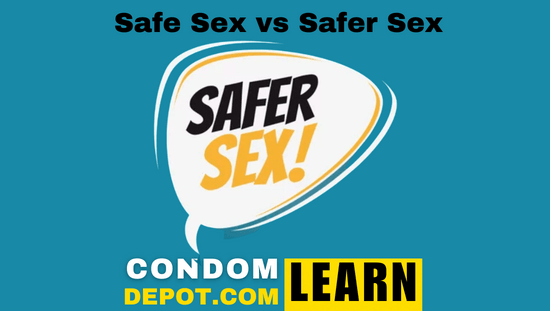Learn

Safe Sex vs Safer Sex
Here at Condom Depot, we like to use the term “safer sex,” as opposed to just “safe sex,” to describe taking control of your own sexual health by using contraceptives such as condoms.
Researching and learning about the possible consequences of unprotected sex, to ultimately make the smartest, most informed decisions when it comes to doing the deed. But really, what’s the difference between “safer sex” and “safe sex”?
Often times “safe sex” and “safer sex” are used interchangeably, because people do not typically know the difference, however, safer sex is a much more accurate term. This term is used instead of safe sex because any kind of sexual activity with a partner is never guaranteed to be 100 percent safe.
Using the term “safe sex” often gives people a false sense of security and discourages communication, frequent testing, and some of the other components included in a comprehensive (and very necessary!) safer sex approach. Consequently, the comprehensive approach has morphed to encompass a group of activities more closely aligned with someone’s overall sexual health and includes practices other than just using a condom (or other barrier), which the older phrase traditionally emphasized.
Basically, safer sex is not just the act of wrapping it up (using a condom) but what happens before and after sexual activity.
So...What Exactly Is Safer Sex?
The STD Project breaks safer sex down into four basic steps that virtually anyone who is sexually active can take before/during sexual activities to help reduce the risk of contracting or transmitting STDs. When all of the steps done together, one can be fully responsible for their own sexual health.
Step One: Communication is key! Discuss with your partner before any sort of sexual activity. Sure, this can be a bit awkward at first, but seriously, it’s important that you’re on the same page. Bring up questions like:
-
Has either you or your partner (or any of your past partners) ever had an STD? If so, when? Was it treated? Did it come back and/or were you re-tested after treatment?
-
Have you been tested – if so, when, for which STDs, and have you had partners since?
-
How many sexual partners have you and your partner had in the last six months – what did you both do to make sex safer? Have you both been tested since?
-
What do you and your partner usually do to make sex safer and what do you both plan to do when you engage in sexual activities with one another?
Step Two: Have full STD screenings and sexual health exams at least once a year and more often if you have new or multiple partners. Condom Depot’s guide to Getting Tested For STDs will help alleviate any fears or questions you have about this.
Step Three: Use barriers, like condoms, consistently and correctly.
Step Four: Consider making safer lifestyle choices to reduce risk. Reduce the number of multiple partners – one after another, or more than one at a time, and limit/eliminate drugs and alcohol when engaging in sexual activities.
Communication is key and if there is a lack of communication or an unwillingness to engage in the safer sex activities listed above, know when to say no. Your body and your health are your first priority and a mature and responsible partner will respect your boundaries and will appreciate your efforts to keep both of you safer.










